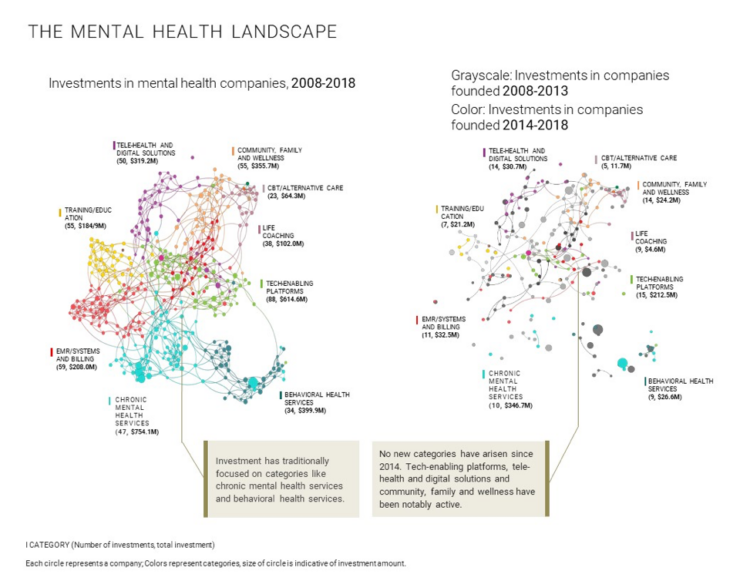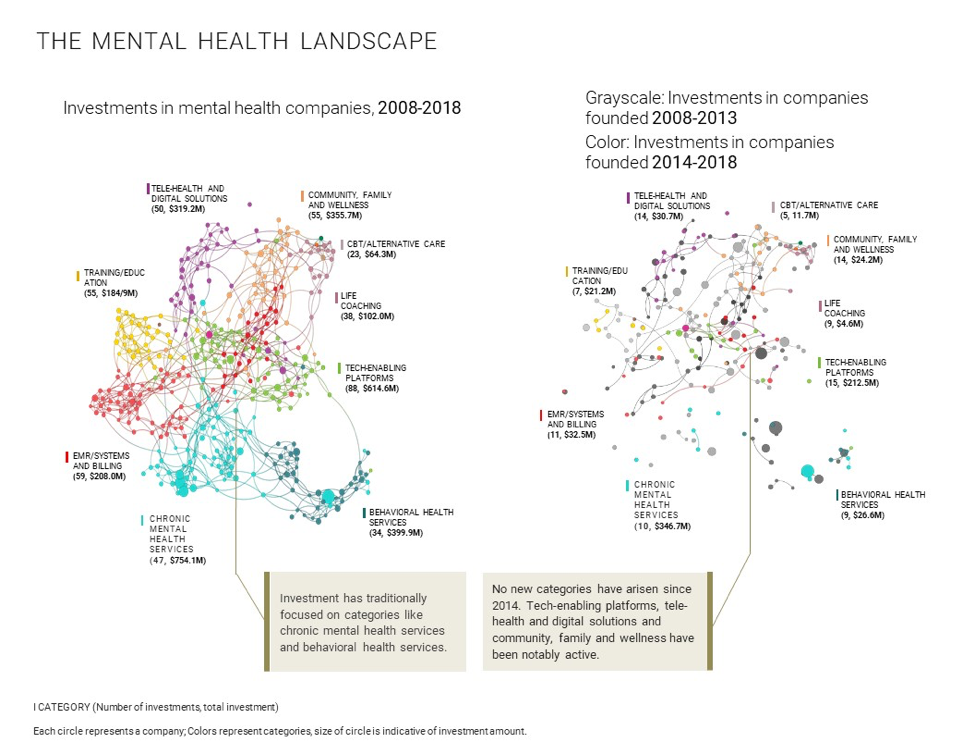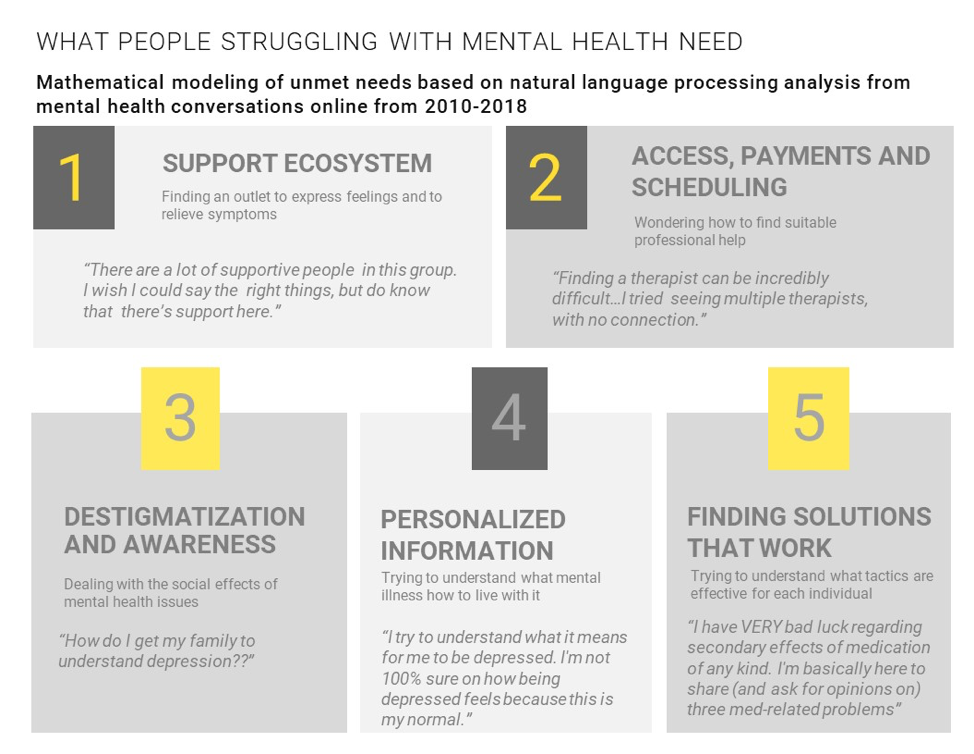Issues like anxiety and depression are more pervasive now than ever, among people from all walks of life. According to the National Institute of Mental Health, one in five people suffer from mental illness, and unfortunately, the stigma surrounding it continues to prevent people from seeking help. As a venture capitalist with a focus on healthcare, I’ve had the opportunity to hear from several mental health startups over the past few years. I’ve found that most of these companies do not aim to solve depression, to cure anxiety, or to manage the entire patient journey. Instead, they tend to focus on “sliver” solutions, concentrating on one aspect of the patient journey by helping users schedule appointments or relieve anxiety through apps. Is there a lack of innovation in the mental health space, and if so, how can we change that?
The Most Surprising Thing About the Current Mental Health Landscape
The most surprising thing about the non-therapeutic mental health landscape is how little it has changed over the past few years. Using powerful data analysis software Quid, machine learning algorithms organized private companies in mental health into nine categories based on their company and product descriptions (depicted below in different colors). $3B was invested in this space from 2008 to 2018. Though investment reached a peak in 2015-2016 (with more than $600M in investment in both years), 2017 saw a slight drop with $500M in investment in the space, which still, however, is a 66 percent increase since 2013.
Investment in companies founded in the past four years has seen a particular focus on categories like telepsychiatry and digital solutions (14 investments, $30.7M invested), community, family and wellness, which aim to provide general, non-clinical support (14 investments, $24M invested), as well as on tech-enabling platforms that aim to improve and streamline various processes within the space (15 investments, $212.5M invested). These categories saw proportionally greater shares of the capital invested in the space compared to 2008-2013. Meanwhile, categories like outpatient care (9 investments, $26.1M invested) and EMR/medical systems and billing have seen a relative plateau in investment (11 investments, $32M invested), while funding for services and facilities for tackling chronic mental health (10 companies, $346M invested, though due primarily to significant investment in a single company) remained relatively robust and active, as in previous years.
Comparing the past four years to the past ten, no new categories have emerged. That is striking. It means that during this period startups have not collectively done anything unique enough to change the industry landscape, which would lead to the creation of a new category of companies or redefine legacy systems. If this was an analysis of a different space, like oncology, there would be a range of new and innovative solutions: Immuno-oncology, CAR-T therapies, liquid biopsies, and precision medicine—innovations toward the treatment of cancer that have completely changed everything about how the disease is approached, from detection, to treatment, and in some cases, even prevention. Where is this sort of innovation in the mental health space? It is also a bit jarring to see that something that affects us so much has received so little funding in comparison with other spaces, like the nearly $5.3B invested in travel tech in 2017, or the $1.1B invested in AR startups in 2016. It is clear that people are not satisfied with the status quo, so why is no one stepping up to redefine the mental health landscape?
The Biggest Unmet Needs in Mental Health
It’s crucial to listen to the needs people suffering from mental health conditions are expressing, and the technology exists to do this at scale. Again via Quid, and using natural language processing, random sampling of posts from two top mental health forums were read in a de-identified and unbiased way. The machine helped identify the top unmet needs expressed by forum users (detailed below). The most commonly voiced concerns were related to finding support, care access, payments and reimbursement, and awareness (both personal and societal). People struggled to find a safe community that really cared or understood what they were going through. Accessing and scheduling appointments with the right physicians or healthcare professionals were so difficult that people often gave up. These needs are obvious, making it all the harder to see them being voiced time and again, by people that need, want, and deserve help. This tells us that raising awareness is not enough: the industry needs accessible, personalized treatment, and there is no time to waste.
We Have a Responsibility to Humanity to Fix What’s Broken
Even if awareness is high, access to help isn’t always included through insurance plans, and when it is, it can be expensive or difficult to arrange. Institutions and organizations talk about mental health awareness but do little to create a culture that accepts it. Healthcare companies put out small solutions, but none are personalized enough. I am calling for startups to take on those challenges. Be the first mental health unicorn. Here’s how:
- Don’t build another sliver solution
Keep the patient journey in mind, and design solutions that eliminate pain points in more than just one aspect of that journey. Alternatively, try and eliminate the need to go through a journey at all by finding or enabling a cure. While newly-founded startups continue to build more elegant solutions within existing categories in the mental health space, there is a huge opportunity to pause and build one that can bridge these categories or even fill the whitespace. Let your solution be rooted in science and data but break out of the existing categories and take on a bigger challenge than just one aspect of the process chain. Yes, your work will be tougher and the road will be longer for you and the people you recruit, but this sort of vision will have a far greater impact on the world. Work with thought leaders and experts in the field to break out of existing categories and come up with a grander vision.
- Demonstrate Clear, Personalized Outcomes
Find ways to tailor solutions to users’ needs, and to show that these solutions actually work. Finding personalized solutions and information still remain top priorities for people struggling with mental health issues. Yet, despite the fact that in 2017 nearly $500M went into companies and services trying to improve the mental health space, few offered substantive personalization options. Much as oncologists have embraced personalized medicine (biomarkers and individual patient data) to have better treatment efficacy, a truly revolutionary mental health solution will be able to demonstrate better tangible outcomes to each person without too much experimentation to find the right solution. While designing personalized solutions can delay the launch of your minimum viable product (MVP), ultimately it will be the very reason that drives value and helps your company sustain the test of time.
- Figure Out Access and Reimbursement Challenges Early
Design solutions with accessibility and cost-effectiveness in mind from day one. A solution cannot be revolutionary, even if it is perfectly designed, yet becomes a burden for people to afford or easily access. In fact, figuring out how to find and pay for suitable professional help remains the #2 unmet need. Be creative in your approach to tackle accessibility. Work with employers and insurance companies (after all, mental health is an economic issue, too) to make your innovative solutions available to everyone who needs it.
We have a responsibility as investors, as medical professionals, and as people who are innovating in this space to address these unmet mental health needs. Perhaps the challenges in the mental health space are greater than in most other spaces, and it may often seem that there are no good solutions, but I cannot believe the reason we are not seeing this sort of innovation in the mental health space is not due to a lack of adequate data or a shortage of passionate psychiatrists and clinicians. These issues touch all of our lives, but as long as people continue to focus on small-scale solutions, at the end of the day, the space will not move forward.





